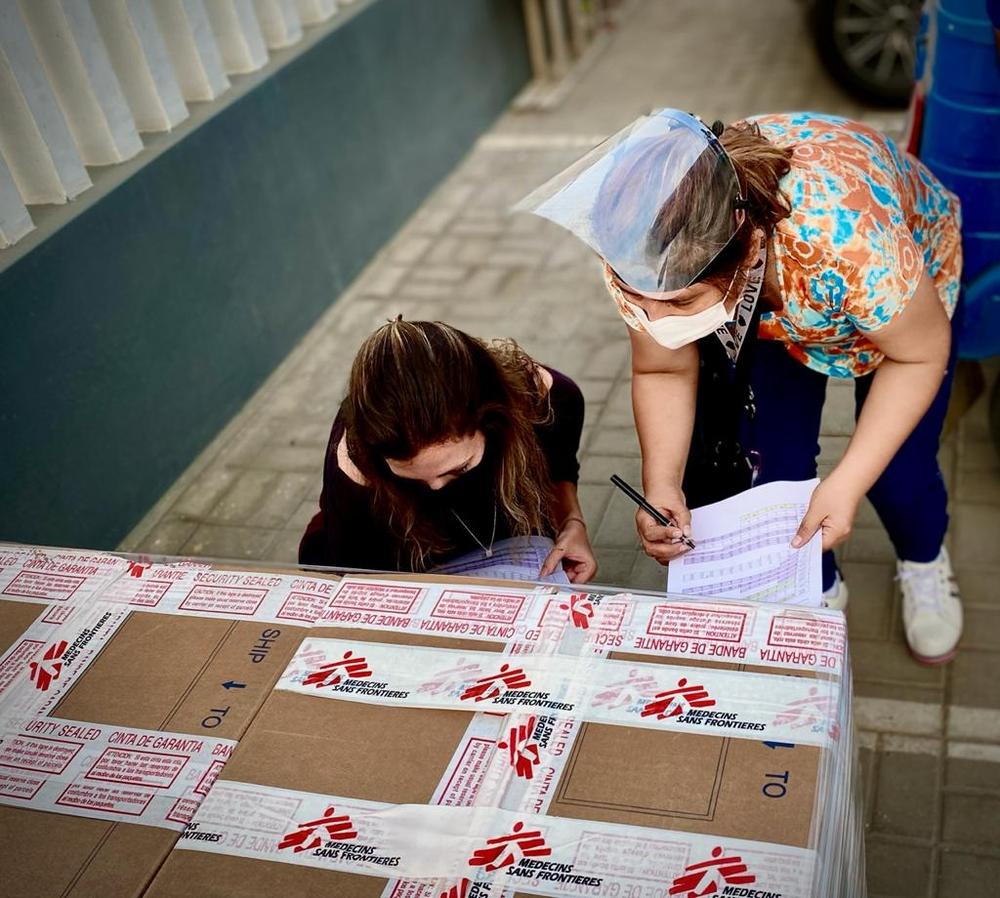Exceptional mortality and hospitals facing collapse in COVID-19-stricken Peru

MSF staff checking the drugs and equipment they just received to support the recently launched COVID-19 intervention in Huaura province, north of Lima, Peru. Local capacity for medical treatment and oxygen therapy is dramatically insufficient to meet the needs. © Jean-Baptiste Marion/MSF
A new, brutal wave of COVID-19 has swept Peru over the past few weeks, resulting in overcrowded hospitals and high mortality rates, while access to vaccination remains a major challenge for the response. Doctors Without Borders/Médecins Sans Frontières (MSF) joined the health authorities north of Lima to strengthen the outbreak management in the area.
A deadly wave of COVID-19 is overwhelming Peru, where hospitals are struggling and critically lacking oxygen supplies, while infection rates are driven up by the presence of the P1 variant, commonly referred to as the Brazilian variant. According to WHO data[1], in the first week of April, Peru, with a population of around 33 million, reported an average of almost 10,000 new cases and 300 deaths per day. The number of deaths represented an increase in excess of 50 percent over the previous week. As a result, the country now suffers from the highest number of excess deaths in the world relative to the population[2]. Medical staff is already stretched to its maximum capacity and beyond, while intensive care resources are insufficient to meet the needs. These issues are compounded by scarce access to badly-needed vaccination: just three percent of the population has received at least the first dose. All of this is preventing the health care system from mounting an adequate outbreak response.
Facing the surge in the number of COVID-19 patients
Following an assessment carried out earlier in the year, Doctors Without Borders/Médecins Sans Frontières (MSF) launched an emergency intervention in collaboration with the health authorities in Huaura province, north of Lima, where the regional hospital in the provincial capital, Huacho, is severely short-handed in facing the surge in the number of COVID-19 patients.
“Our intervention has two main objectives”, says Jean-Baptiste Marion, MSF head of mission. “We want to help to take pressure off Huacho hospital and the local health care system through an ancillary facility, where we can treat COVID-19 patients and provide them with oxygen when needed. Today, many non-critical patients end up in Huacho hospital, overwhelming the facility. Also, to complement this activity, we work with community networks to improve early detection, looking to identify patients and provide them with the needed level of care before their condition worsens and they end up in critical conditions.”
MSF's response
MSF teams also support Huacho hospital’s intensive care unit, to improve patient management and help through every step of the patient flow.
The approach adopted by MSF is centred on a 50-bed in-patient facility connected to Huacho hospital and a network of local health care centres. Half of these beds are equipped for clinically monitored isolation, while the other half can provide patients with oxygen, including for patients in severe conditions.
The country has now reached a cumulative total of over 1.7 million COVID-19 cases and over 57,000 deaths[3]. A major issue observed by MSF teams on the ground is that people are often reluctant to seek medical care in hospitals when they start showing symptoms, choosing private practices, (which may not always be able to offer the required level of care) or even opting for self-medication. The consequences for an overmatched health system are devastating: people in many cities queue overnight and sleep in the rough to fill up their oxygen tanks from the few working reservoirs, hoping to take care of their relatives at home.
For this reason, MSF is partnering with the local authorities’ community outreach activities, in order to ensure that Covid-19 patients in the province are identified as early as possible and headed in the right direction from the beginning, when seeking healthcare.
“Improving screening and patient management is a priority today”, concludes Jean-Baptiste Marion. “Without an urgent boost in access to vaccination, though, it is hard to expect an improvement any time soon.”
[2] Financial Times, “How excess deaths compare around the world since Covid-19 outbreaks began”. Excess deaths are defined as the number of deaths above the historical average for the period.
[3] Source : Ministry of Health, https://covid19.minsa.gob.pe/sala_situacional.asp